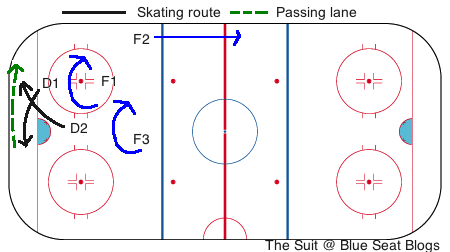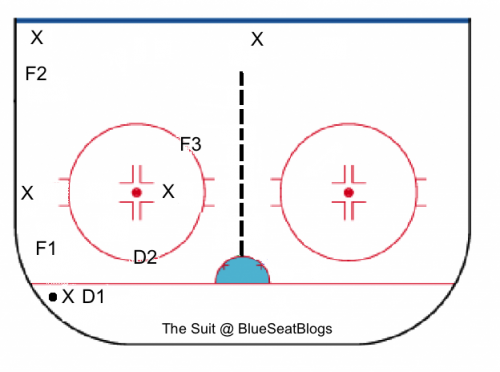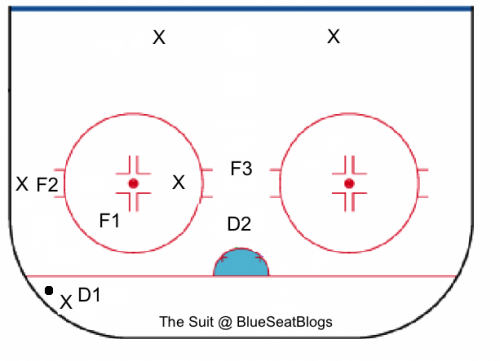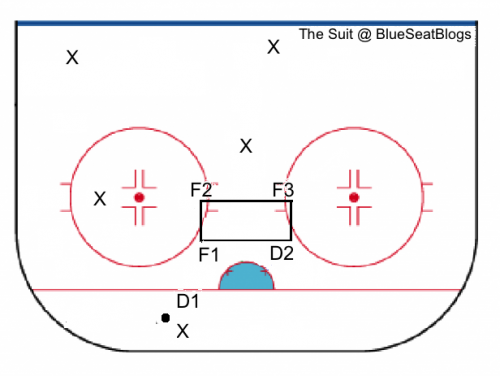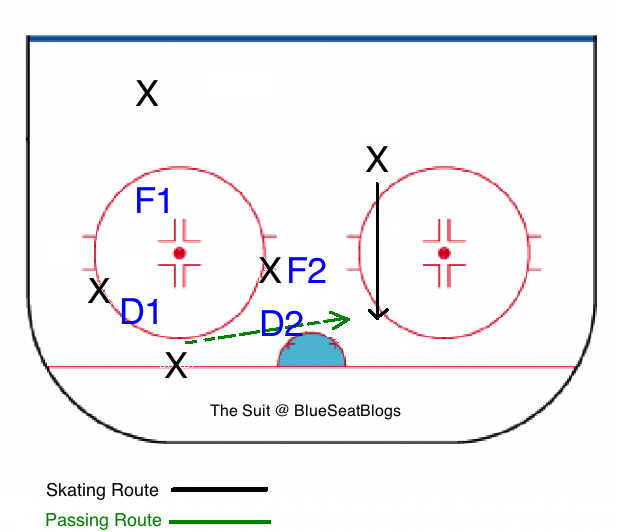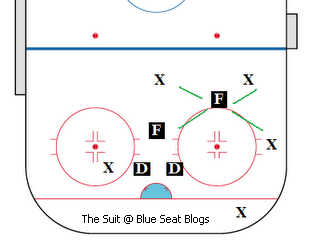The table is set for another round of the Penguins and the Rangers, who seem to meet in the playoffs as often as the Caps and the Rangers. This time around, it will be old friend Mike Sullivan, who was an assistant with the Rangers during the John Tortorella days, behind the bench in Pittsburgh. The change in coach means a change in system from the last time they met in the first round (last year).
The biggest change for the Penguins is that they are run a more aggressive style of play compared to Mike Johnston last year. They are more like Dan Bylsma’s Penguins in this regard, even without half their roster, as Pat pointed out. But even without key players, the Penguins enter the playoffs red hot and have really adopted this new style of play effectively.
Breakouts and Forechecks
Even strength play for the Rangers revolves around creating high chance opportunities off the rush with a steady forecheck and set breakouts. Unfortunately, this hasn’t worked as planned this year, as teams are anticipating the breakout plays and cutting them off in the neutral zone. Compounding this is age, faster opponents, and general ineffective passing, and the Rangers are a predictable team that are easy to defend. The Rangers are skilled enough to score often, but being easy to defend is not a recipe for success in the playoffs.
The forecheck is an area where the Rangers need to commit in order to alleviate the issues of being predictable. They are still an effective forechecking team, but are also prone to predictability. the first man in will pressure the puck, and depending on puck location/play, the second will pressure the primary passing option, while the third will pressure the secondary passing option. This is generally an effective 1-2-2 forecheck.
Sullivan’s Penguins can counter this by anticipating the pressure and running a reverse breakout. In Kris Letang, they have a tremendous puck mover with great vision. The Penguins are skilled enough to break through the forecheck, and it’s something to watch for.
While the Rangers run a 1-2-2 to cut off options, Sullivan has switched his Penguins to a 2-1-2 in a more direct approach to causing turnovers. Their team speed is a great asset here, sending two guys after the puck carrier and forcing his hand. Carl Hagelin and Phil Kessel, if on their games, will be tenacious. You should be familiar with the 2-1-2 forecheck, as it’s what Torts used during his tenure here.
Defensive Zone
The Rangers’ defensive zone scheme is well known at this point. Or at least people think they know it. Folks will tell you that the Rangers play straight man coverage. But this is in fact, incorrect. The Rangers play an overload-man hybrid system, designed to overload the half-boards and create turnovers. Depending on puck location, certain players will switch to man coverage, specifically D1 and D2, to create more pressure. This is why you sometimes see defensemen pressuring a forward at the blue line.
This worked like a charm in 2013-2014. It worked last season, although was less effective. It has not worked this season, as age and deteriorating skill sets –along with, in my opinion, improper deployment– have rendered the hybrid ineffective. Effectiveness be damned, this is what the Rangers will run.
The Penguins are a much simpler team, running a standard overload and zone system. The zone will look like an overload, and naturally the look will change depending on puck location. If the puck winds up behind the net, you could see them shift to a box+1, pictured below.
Considering the injuries to the Penguins, sustained offensive pressure might be easier to come by. The Rangers have a skilled group of forwards who can exploit openings in the defensive zone. It’s a matter of capitalizing.
Special Teams
Special teams are a doozy for the Rangers. They actually have a pretty successful powerplay now that they are running it through Keith Yandle, but the potential absence of Ryan McDonagh throws a wrench into things. Regardless, they will be running a 1-3-1 or umbrella (more or less a 3-2) powerplay, depending on the unit and how the play is developing. Powerplays in the NHL aren’t creative anymore since the advent of the 1-3-1. Sullivan runs the same hybrid approach as AV. There’s not much else here.
As for the penalty kill, well the Rangers stink. They allow the lateral pass way too much, and it almost always ends up in the back of their net. In fact, they are so bad they allow the same play to happen twice:
https://twitter.com/BlueSeatBlogs/status/718247752975695872
Suit covered what the issues are quite extensively, and you should read up on that. It goes beyond allowing that lateral pass, as the Rangers are just soft on the penalty kill all around. The diamond force penalty kill simply doesn’t work anymore for the same reasons why the hybrid zone/man defensive zone schemes don’t work anymore. It’s a major problem for the Rangers.
Sully is a much simpler guy, preferring to run a straight zone with his team on the penalty kill. You’ll see them in your standard diamond or box formations, but Sully will also throw a wedge+1 –the system I want the Rangers to adopt– at you. This is similar to a diamond force, but simpler to execute as it is still just a zone strategy.
In the end, it doesn’t matter what system is run. It matters how the players execute these systems. The Rangers haven’t executed all year. The Penguins only recently started playing well over the last two months. Execution will be key. As clichéd as it sounds, the team that commits the fewest mistakes should come out on top.
Share:
More About:Playoffs Hockey Tactics


